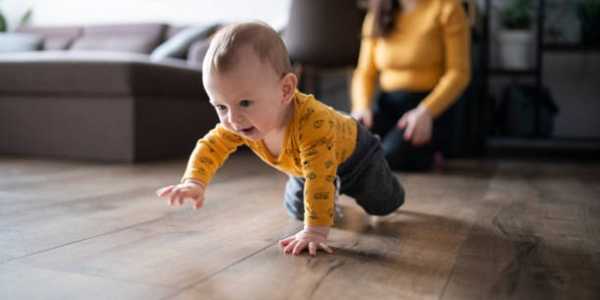How To Encourage Crawling And Early Movement

Many parents look forward to the day their baby starts crawling, but it can feel unclear how to help them get there. Crawling is more than a milestone; it helps babies build strength and balance. Here's how you can encourage safe early movement.
Create A Safe Space For Movement
A safe and open area gives babies the freedom to move without danger. Parents should clear away sharp objects, cover outlets, and secure heavy furniture. A soft mat or carpeted floor is suitable for babies to practice crawling without hurting their knees.

Doctors at the American Academy of Paediatrics say that tummy time is one of the best ways to build a baby's neck and shoulder muscles. This helps babies lift their heads, roll over, and crawl with more ease. Parents should place babies on their tummies for short periods during the day while keeping a close eye on them. A few minutes a few times a day is enough at first.
Use Toys To Motivate Crawling
Babies love colourful toys and shiny objects. Parents can use toys to motivate a baby to move. Placing a toy just out of reach makes the baby want to stretch, reach, and crawl forward. This simple trick works well for many babies. Ensure toys are safe and do not contain small parts that can be swallowed.
Some parents use mirrors to help. Babies are often interested in their reflection. A baby-safe mirror placed near the floor can make tummy time more fun. Moving toys or sound-making toys also keep babies excited to move and explore.
Dress Babies For Comfort And Movement
What a baby wears can affect how easily they move. Loose clothing that allows legs and arms to move freely is best. Avoid wearing tight pants or dresses that can make crawling more difficult. Bare feet often help babies get a better grip on the floor. If the house is cold, soft socks with grip can keep feet warm and prevent slipping.

Limit Time In Carriers And Swings
Carriers, swings, and baby chairs are helpful tools, but should not be used too much. Babies need freedom to move and practice their skills. Spending too much time strapped in can slow down muscle strength. Pediatric therapy experts recommend giving babies numerous opportunities each day to lie on the floor, roll around, and push up on their arms.
Play And Interact On The Floor
Getting down on the floor and playing with babies makes a big difference. Babies feel safe when a parent or caregiver is close. They will try to reach and move toward familiar voices and faces. Making funny faces, singing songs, and clapping hands all help babies stay active.
The Centres for Disease Control and Prevention reminds parents to watch for key milestones. By six months, many babies can roll in both directions. By 9 months, many start to crawl or scoot. If you have any concerns about slow movement, it is advisable to consult a paediatrician for guidance.
Try Simple Exercises For Stronger Muscles
Light exercises during playtime help strengthen muscles. Gently holding a baby's hands while they push their feet against a soft surface can help build leg strength. Rolling a smooth ball back and forth encourages children to reach and move their hands.
Tummy time should always be done when the baby is awake and under adult supervision. Babies should never sleep on their stomachs, as this raises the risk of Sudden Infant Death Syndrome (SIDS).

Encouraging Crawling Checklist
1. Create a Safe Space
Apparent sharp objects and cover outlets
Secure heavy furniture
Use a soft mat or carpet for practice
2. Daily Tummy Time
Place the baby on the tummy while awake, for a few minutes at a time
Supervise closely and engage with your baby
Use a baby-safe mirror to make tummy time fun
3. Use Toys for Motivation
Place colourful toys just out of reach
Use safe toys without small parts
Try soft balls and noise-making toys to encourage movement
4. Dress for Movement
Use loose, comfortable clothing
Let the baby go barefoot or use grip socks if needed
Avoid tight pants or dresses
5. Limit Time in Carriers & Swings
Allow daily floor time for free movement
Reduce the extended use of bouncers or seats
6. Floor Play & Interaction
Get down on the floor with your baby
Encourage reaching by calling or singing
Clap and smile to praise small efforts
7. Simple Strength Exercises
Let the baby push against your hands or a soft surface
Roll a soft ball to encourage reaching and crawling motions
8. Watch Milestones
Rolling both ways by 6 months
Crawling or scooting by around 9 months
Consult a paediatrician if concerned about delays
9. Be Patient and Positive
Celebrate small progress and efforts
Avoid comparisons with other babies
Keep the environment fun and stress-free
Conclusion
No two babies are the same. Some crawl early, while others go straight to standing or walking. Stay patient and keep it fun, praising small efforts along the way. Encouraging crawling isn't just about hitting milestones—it helps build strong muscles and balance for future movement and physical development. By providing babies with a safe space, time to practice, and plenty of love, parents help them grow strong and confident, ready to explore the world on their terms.









